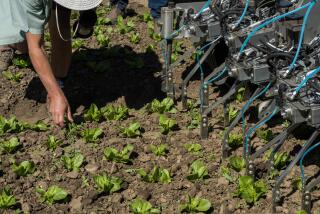As bee populations dwindle, robot bees may pick up some of their pollination slack

Scientists in Japan say they’ve managed to turn an unassuming drone into a remote-controlled pollinator.
One day, gardeners might not just hear the buzz of bees among their flowers, but the whirr of robots, too. Scientists in Japan say they’ve managed to turn an unassuming drone into a remote-controlled pollinator by attaching horsehairs coated with a special, sticky gel to its underbelly.
The system, described in the journal Chem, is nowhere near ready to be sent to agricultural fields, but it could help pave the way to developing automated pollination techniques at a time when bee colonies are suffering precipitous declines.
In flowering plants, sex often involves a threesome. Flowers looking to get the pollen from their male parts into another bloom’s female parts need an envoy to carry it from one to the other. Those third players are animals known as pollinators — a diverse group of critters that includes bees, butterflies, birds and bats, among others.
Animal pollinators are needed for the reproduction of 90% of flowering plants and one third of human food crops, according to the U.S. Department of Agriculture’s Natural Resources Conservation Service. Chief among those are bees — but many bee populations in the United States have been in steep decline in recent decades, likely due to a combination of factors, including agricultural chemicals, invasive species and climate change. Just last month, the rusty patched bumblebee became the first wild bee in the United States to be listed as an endangered species (although the Trump administration just put a halt on that designation).

A remote-controlled, bio-inspired flying robot picks up pollen from a lily flower.
Thus, the decline of bees isn’t just worrisome because it could disrupt ecosystems, but also because it could disrupt agriculture and the economy. People have been trying to come up with replacement techniques, the study authors say, but none of them are especially effective yet — and some might do more harm than good.
“One pollination technique requires the physical transfer of pollen with an artist’s brush or cotton swab from male to female flowers,” the authors wrote. “Unfortunately, this requires much time and effort. Another approach uses a spray machine, such as a gun barrel and pneumatic ejector. However, this machine pollination has a low pollination success rate because it is likely to cause severe denaturing of pollens and flower pistils as a result of strong mechanical contact as the pollens bursts out of the machine.”
Scientists have thought about using drones, but they haven’t figured out how to make free-flying robot insects that can rely on their own power source without being attached to a wire.
“It’s very tough work,” said senior author Eijiro Miyako, a chemist at the National Institute of Advanced Industrial Science and Technology in Japan.

The robotic bee takes off.
Miyako’s particular contribution to the field involves a gel, one he’d considered a mistake 10 years before. The scientist had been attempting to make fluids that could be used to conduct electricity, and one attempt left him with a gel that was as sticky as hair wax. Clearly this wouldn’t do, and so Miyako stuck it in a storage cabinet in an uncapped bottle. When it was rediscovered a decade later, it looked exactly the same – the gel hadn’t dried up or degraded at all.
“I was so surprised, because it still had a very high viscosity,” Miyako said.
The chemist noticed that when dropped, the gel absorbed an impressive amount of dust from the floor. Miyako realized this material could be very useful for picking up pollen grains. He took ants, slathered the ionic gel on some of them and let both the gelled and ungelled insects wander through a box of tulips. Those ants with the gel were far more likely to end up with a dusting of pollen than those that were free of the sticky substance.
The next step was to see if this worked with mechanical movers, as well. He and his colleagues chose a four-propeller drone whose retail value was $100, and attached horsehairs to its smooth surface to mimic a bee’s fuzzy body. They coated those horsehairs in the gel, and then maneuvered the drones over Japanese lilies, where they would pick up the pollen from one flower and then deposit the pollen at another bloom, thus fertilizing it.
The scientists looked at the hairs under a scanning electron microscope and counted up the pollen grains attached to the surface. They found that the robots whose horsehairs had been coated with the gel had on the order of 10 times more pollen than those hairs that had not been coated with the gel.
“A certain amount of practice with remote control of the artificial pollinator is necessary,” the study authors noted.
Miyako does not think such drones would replace bees altogether, but could simply help bees with their pollinating duties.
“In combination is the best way,” he said.
There’s a lot of work to be done before that’s a reality, however. Small drones will need to become more maneuverable and energy efficient, as well as smarter, he said — with better GPS and artificial intelligence, programmed to travel in highly effective search-and-pollinate patterns.
Follow @aminawrite on Twitter for more science news and “like” Los Angeles Times Science & Health on Facebook.
MORE IN SCIENCE:
Using science to see which countries are following through on Paris climate change goals
What makes a frog’s tongue so sticky? The secret is in the spit
How to reset your body clock — and get better sleep — with hiking boots and a tent







